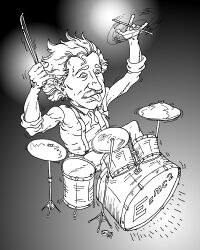Template:Are You Sure/October 17: Difference between revisions
No edit summary |
No edit summary |
||
| Line 1: | Line 1: | ||
[[File:Einstein drumming.jpg|link=Albert Einstein|200px|thumb|1927: Pioneering jazz drummer and theoretical physicist [[Albert Einstein]] premiers his famous "[[Banks of the Sane]]" riff at [[The Blue Code]] jazz club and software development cooperative in the Harlem of New York City. A young [[Buddy Rich (nonfiction)|Buddy Rich]] is in the audience. The next night, Rich will audition for the Albert Einstein Band, astounding everyone by playing "Banks of the Sane" with what Einstein will later call "note-for-note-accuracy," yet with "fresh feeling, a true spontaneous genius."]] | [[File:Einstein drumming.jpg|link=Albert Einstein|200px|thumb|1927: Pioneering jazz drummer and theoretical physicist [[Albert Einstein]] premiers his famous "[[Banks of the Sane]]" riff at [[The Blue Code]] jazz club and software development cooperative in the Harlem district of New York City. A young [[Buddy Rich (nonfiction)|Buddy Rich]] is in the audience. The next night, Rich will audition for the Albert Einstein Band, astounding everyone by playing "Banks of the Sane" with what Einstein will later call "note-for-note-accuracy," yet with "fresh feeling, a true spontaneous genius."]] | ||
• ... that mathematician, philosopher, inventor and mechanical engineer '''[[Charles Babbage (nonfiction)|Charles Babbage]]''' (26 December 1791 –18 October 1871) was a pioneer of programmable computing? | • ... that mathematician, philosopher, inventor and mechanical engineer '''[[Charles Babbage (nonfiction)|Charles Babbage]]''' (26 December 1791 –18 October 1871) was a pioneer of programmable computing? | ||
Revision as of 14:26, 17 October 2020

• ... that mathematician, philosopher, inventor and mechanical engineer Charles Babbage (26 December 1791 –18 October 1871) was a pioneer of programmable computing?
• ... that mathematician Jacques Hadamard (8 December 1865 – 17 October 1963) contributed to number theory, complex function theory, differential geometry and partial differential equations; and that Hadamard described the creative process as having four steps: Preparation, Incubation, Illumination, and Verification?
• ... that astronomers Wilhelm Fabry, Michael Maestlin and Helisaeus Roeslin were able to make observations of the supernova now known as Kepler's Supernova on 9 October, but did not record the supernova; that the first recorded observation in Europe was by Lodovico delle Colombe in northern Italy on 9 October 1604; that Johannes Kepler was only able to begin his observations on 17 October while working at the imperial court in Prague for Emperor Rudolf II; and that the supernova was subsequently named after him, even though he was not its first observer, as his observations tracked the object for an entire year?